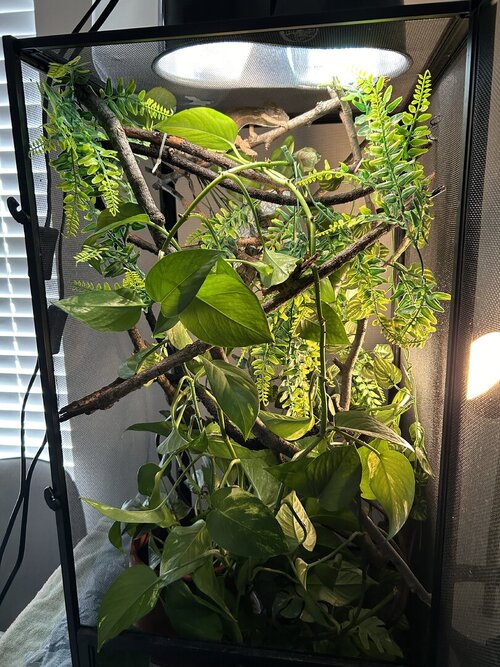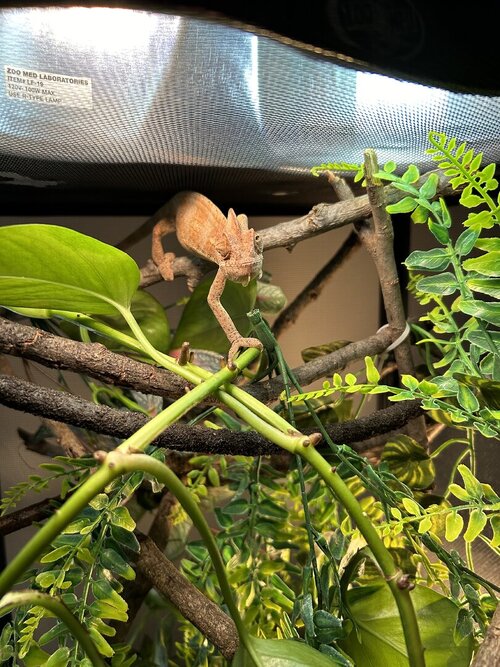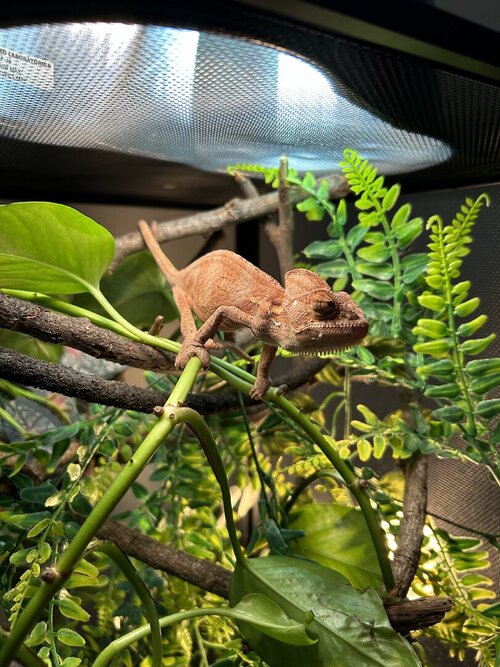jabrown6
New Member
Interesting situation; my friend has a female veiled chameleon and they are out of town and asked if I could take care of it. I have never own a chameleon before so I wanted to make sure I was taking good care of their chameleon while they were gone.
They said she has been brown for a while now. I did a lot of research to educate myself on what kind of habitat that I needed to set up for her while she was at my house. With all this research, I quickly saw that the temp, humidity levels and the feeding was not what it should have been and also the cage setup itself.
So I changed all of that and now the day temps are 70-75F with 40-50% humidity and basking temp 80-85F with a uvb (compact not linear, I want to get a linear for her) and the night temp is 60-65F with 80-100% humidity and no lights. I have a dripper with a live plant. She drinks off the leaves, she eats crickets and meal worms that have calcium powder and I don't handle her at all so I don't stress her out. She loves to eat off of my hands and seems quite hungry but I don't want to overfeed her. I am setting up a laying bin for her tonight just in case she is gravid. I have hiding spots for her with lots of horizontal twigs and branches to crawl around and be hidden from. She is off of the ground, eye level or higher and away from the window and when i leave, no one else is in the room so she doesn't get stressed. I have done about all I can to get her habitat to be just right and yet she is completely tan and brown with no green at all. Maybe just getting used to the house and stressed becuase of that, which stinks cuz she will be leaving in two days and that will stress her out even more.
Can anyone tell me why my female veiled chameleon might be tan/brown all the time? She is even tan/brown while sleeping.
Any help is greatly appreciated.
They said she has been brown for a while now. I did a lot of research to educate myself on what kind of habitat that I needed to set up for her while she was at my house. With all this research, I quickly saw that the temp, humidity levels and the feeding was not what it should have been and also the cage setup itself.
So I changed all of that and now the day temps are 70-75F with 40-50% humidity and basking temp 80-85F with a uvb (compact not linear, I want to get a linear for her) and the night temp is 60-65F with 80-100% humidity and no lights. I have a dripper with a live plant. She drinks off the leaves, she eats crickets and meal worms that have calcium powder and I don't handle her at all so I don't stress her out. She loves to eat off of my hands and seems quite hungry but I don't want to overfeed her. I am setting up a laying bin for her tonight just in case she is gravid. I have hiding spots for her with lots of horizontal twigs and branches to crawl around and be hidden from. She is off of the ground, eye level or higher and away from the window and when i leave, no one else is in the room so she doesn't get stressed. I have done about all I can to get her habitat to be just right and yet she is completely tan and brown with no green at all. Maybe just getting used to the house and stressed becuase of that, which stinks cuz she will be leaving in two days and that will stress her out even more.
Can anyone tell me why my female veiled chameleon might be tan/brown all the time? She is even tan/brown while sleeping.
Any help is greatly appreciated.








